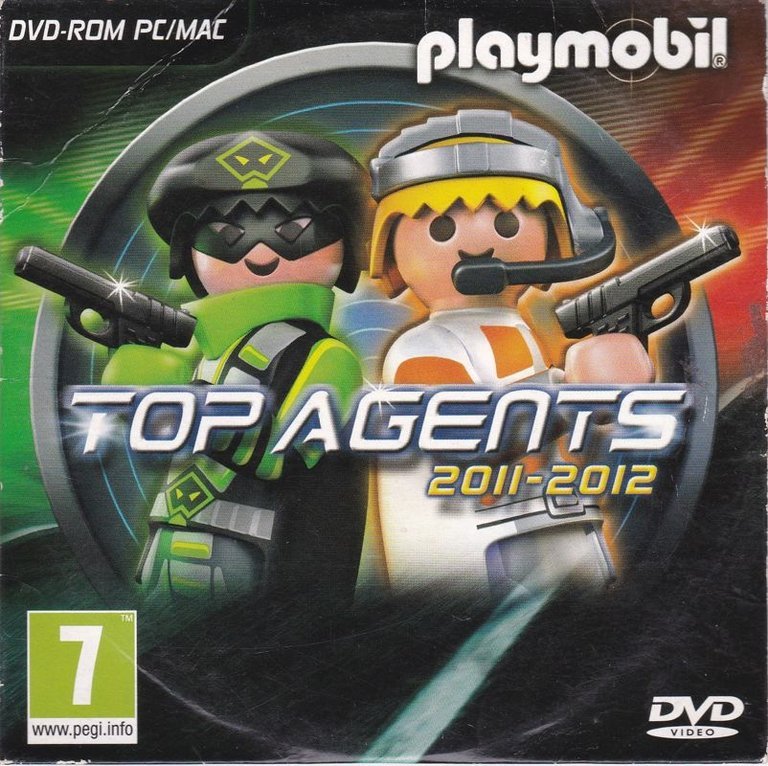- Release Year: 2011
- Platforms: Macintosh, Windows
- Publisher: Playmobil Interactive
- Genre: Action, Puzzle
- Perspective: 3rd-person
- Game Mode: Single-player
- Gameplay: Code entry, Dodging, Mini-games, Shooting, Spot-the-odd-one-out
- Setting: espionage, Fantasy, Spy

Description
Playmobil Top Agents 2011-2012 is a PC game based on the 2010 Nintendo DS title, where players join the Top Agents in battling Dr. Devil and his Robo Gang. The game features a DVD animated movie and a series of mini-games accessed via golden CDs in the Top Agent’s HQ, including shooting, puzzle, and action challenges. Each mini-game is unique and requires different skills to defeat Dr. Devil’s schemes.
Playmobil Top Agents 2011-2012 Reviews & Reception
commonsensemedia.org : Subpar controls and tutorials make toy-based game fizzle.
Playmobil Top Agents 2011-2012: Review
Introduction
Playmobil Top Agents 2011-2012 stands as a curious footnote in the annals of licensed video games. Part toy commercial, part episodic spy adventure, this PC release expanded upon the Nintendo DS original by adding DVD movie content and a suite of mini-games. Our goal here is to dissect the game’s various elements to determine its lasting impact and entertainment value.
Development History & Context
The game’s origins trace back to the 2010 Nintendo DS release of Playmobil Top Agents. Rather than a direct port, the PC version was designed to complement the existing toy line with interactive experiences. Developed by Playmobil Interactive, this title reflects the era’s emphasis on creating digital media tie-ins for physical products. Technological constraints of the time—moderate PC specifications and DVD-based content delivery—influenced the design, resulting in a hybrid approach that combined traditional video game elements with linear movie segments.
Narrative & Thematic Deep Dive
The narrative revolves around a classic spy-vs.-evil genius trope: Dr. Devil seeks to unleash chaos via Robo Gang henchmen, and the Top Agents must thwart him. Each mini-game corresponds to a mission segment, with briefings and cutscenes linking the action. Themes of teamwork, gadgetry, and beating the odds pervade the storyline. However, the episodic structure and toy-promotional undertones may limit narrative depth for older audiences.
Gameplay Mechanics & Systems
The gameplay consists of five distinct mini-games, each with unique mechanics:
1. Duel With Dr. Devil: A precision-based shooter where players click colored bubbles to score points.
2. Sea Chase: A dual-character control scheme requiring players to switch between Jet Girl and Agent Sub to attack and defend.
3. Code Breaker: A timed pattern recognition challenge with increasing complexity.
4. Truck Attack: A vehicle evasion game where avoiding attacks reveals activation codes.
5. Movie: A passive experience, but integral to the overall story progression.
Each mini-game features introductory instructions and a control overview. However, the lack of in-depth tutorials or practice modes may frustrate younger players. The interface is straightforward, relying on mouse interactions and on-screen prompts.
World-Building, Art & Sound
Visually, the game embraces its Playmobil roots with colorful, stylized graphics that mimic the toy line’s aesthetic. Characters and environments are rendered in a fixed/flip-screen perspective, enhancing the toy-like charm. Sound design includes upbeat background music, cartoonish sound effects, and voice acting that adds personality to the characters. While not groundbreaking, the audiovisual presentation effectively immerses players into the Top Agents universe.
Reception & Legacy
Critical and commercial reception for Playmobil Top Agents 2011-2012 remains elusive, with major review outlets offering no coverage. The DS version received mixed feedback, highlighting issues with controls and tutorial quality. Its influence on subsequent games appears negligible, though it continues the trend of Playmobil-licensed games that prioritize product promotion over innovation.
Conclusion
Playmobil Top Agents 2011-2012 occupies a niche in video game history as a well-intentioned but limited licensed title. While it offers engaging mini-games and a charming aesthetic, its toy-focused design and simplistic gameplay mechanics limit its appeal outside the core audience. As a historical artifact of early 2010s advergaming, it’s a curiosity worth acknowledging, but its impact on the industry is minimal.